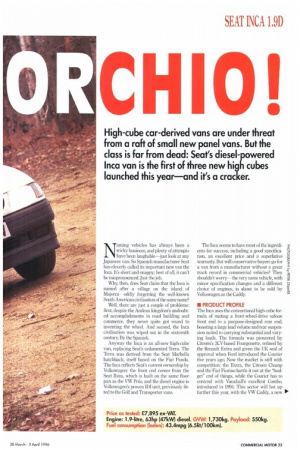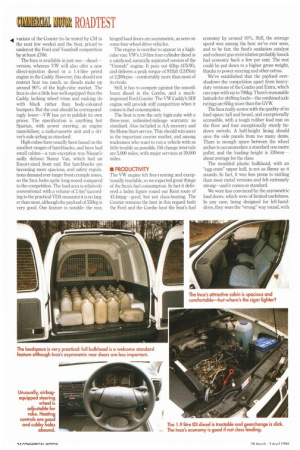High-cube car-derived vans are under threat from a raft of
Page 25

Page 26

Page 27

Page 28

If you've noticed an error in this article please click here to report it so we can fix it.
small new panel vans. But the class is far from dead: Seat's diesel-powered Inca van is the first of three new high cubes launched this year—and it's a cracker.
1\1" aming vehicles has always been a tricky business, and plenty of attempts have been laughable—just look at any Japanese van. So Spanish manufacturer Seat has cleverly called its important new van the Inca. It's short and snappy; best of all, it can't be mispronounced. Just the job.
Why, then, does Seat claim that the Inca is named after a village on the island of Majorca oddly forgetting the well-known South American civilisation of the same name?
Well, there are just a couple of problems: first, despite the Andean kingdom's undoubted accomplishments in road building and commerce, they never quite got round to inventing the wheel. And second, the Inca civilisation was wiped out in the sixteenth century. By the Spanish.
Anyway the Inca is an all-new high-cube van, replacing Seat's unlamented Terra. The Terra was derived from the Seat Marbella hatchback, itself based on the Fiat Panda. The Inca reflects Seat's current ownership by Volkswagen: the front end comes from the Seat Ibiza, which is built on the same floor pan as the VW Polo, and the diesel engine is Volkswagen's proven IDI unit, previously fitted to the Golf and Transporter vans. The Inca seems to have most of the ingredients for success, including a good specification, an excellent price and a superlative warranty But will conservative buyers go for a van from a manufacturer without a great track record in commercial vehicles? They shouldn't worry—the very same vehicle, with minor specification changes and a different choice of engines, is about to be sold by Volkswagen as the Caddy.
• PRODUCT PROFILE The Inca uses the conventional high-cube formula of mating a front-wheel-drive saloon front end to a purpose-designed rear end, boasting a large load volume and rear suspension suited to carrying substantial and varying loads. The formula was pioneered by Citroen's 2CV-based Fourgonette, refined by the Renault Extra and given the UK seal of approval when Ford introduced the Courier five years ago. Now the market is stiff with competition: the Extra, the Citroen Champ and the Fiat Fiorino battle it out at the "budget" end of things, while the Courier has to contend with Vauxhall's excellent Combo, introduced in 1994. This sector will hot up further this year, with the VW Caddy, a new 110. -4 variant of the Courier (to be tested by CM in the next few weeks) and the Seat, priced to undercut the Ford and Vauxhall competition by at least £700.
The Inca is available in just one—dieselversion, whereas VW will also offer a new direct-injection diesel or a 1.4-litre petrol engine in the Caddy. However, this should not restrict Seat too much, as diesels make up around 90% of the high-cube market. The Inca is also a little less well-equipped than the Caddy, lacking wheel trims and making do with black rather than body-coloured bumpers. But the cost should be correspondingly lower—VW has yet to publish its own prices. The specification is anything but Spartan, with power steering, an engine immobiliser, a radio/cassette unit and a driver's-side airbag as standard.
High-cubes have usually been based on the smallest ranges of hatchbacks, and have had
small cabins a rare exception was Nissan's sadly defunct Sunny Van, which had an Escort-sized front end. But hatchbacks are becoming more spacious, and safety regulations demand ever-larger front crumple zones, so the Inca looks quite long-nosed compared to the competition. The load area is relatively conventional: with a volume of 2.4m3 (according to the practical VDA measure) it is no larger than most, although the payload of 550kg is very good. One feature is notable: the rear,
hinged load doors are asymmetric, as seen on some four-wheel-drive vehicles.
The engine is overdue to appear in a highcube van: VW's 1.9-litre four-cylinder diesel is a catalysed, naturally aspirated version of the "Umwelt" engine. It puts out 63hp (47kW), and delivers a peak torque of 91Ibft (124Nm) at 2,200rpm—comfortably more than most of its rivals.
Still, it has to compete against the smooth Isuzu diesel in the Combo, and a muchimproved Ford Courier. The VW Caddy's SDI engine will provide stiff competition when it comes to fuel consumption.
The Seat is now the only high-cube with a three-year, unlimited-mileage warranty as standard. Also included is AA recovery and the Home Start service. This should win users in the important courier market, and among tradesmen who want to run a vehicle with as little trouble as possible. Oil change intervals are 5,000 miles, with major services at 20,000 miles.
• PRODUCTIVITY The VW engine felt free-running and exceptionally tractable, so we expected great things of the Inca's fuel consumption. In fact it delivered a laden figure round our Kent route of 43.4mpg—good, but not class-beating. The Courier remains the best in this regard: both the Ford and the Combo beat the Seat's fuel economy by around 10%. Still, the average speed was among the best we've ever seen, and to be fair, the Seat's oxidation catalyst and exhaust gas recirculation probably knock fuel economy back a few per cent. The rest could be put down to a higher gross weight, thanks to power steering and other extras.
We've established that the payload overshadows the competition apart from heavyduty versions of the Combo and Extra, which can cope with up to 700kg. There's reasonable latitude for shifting loads—the combined axle ratings are 65kg more than the GVW
The Inca really scores with the quality of its load space: tall and broad, and exceptionally accessible, with a tough rubber load mat on the floor and four exceptionally sturdy tiedown swivels. A half-height lining should save the side panels from too many dents. There is enough space between the wheel arches to accommodate a standard one-metre pallet, and the loading height is 520mmabout average for the class
The moulded plastic bulkhead, with an "egg-crate" upper half, is not as flimsy as it sounds. In fact, it was less prone to rattling than most metal versions and felt extremely strong—and it comes as standard.
We were less convinced by the asymmetric load doors, which were of limited usefulness. In any case, being designed for left-handdrive, they were the "wrong" way round, with
the larger door on the nearside. Still, the handles and catches were chunky and well finished, while the doors could be opened to 900 or 180°.
And there are heated rear windows and a wash/wipe setup on the larger door—another welcome standard feature.
• ON THE ROAD
Both the ride and handling of car-derived vans is getting better, and the Inca is a clear example of this trend. The driver and load are comfortable at most speeds, the only problem being an occasional up-and-down pogoing when fully laden.
The engine is, as it proved in the VW Golf, very flexible, allowing you to remain in fourth or fifth gear on A-roads—overall gearing lies between the Combo and the long-legged Courier. The gearchange itself is fast and precise one of the best around. Standing-start acceleration times beat the Courier's but are unable to match the highly flexible Combo.
The Seat's front disc/rear drum brake setup is pretty crisp, though we were unable to test it properly because of a wet test track.
Power steering is a worthwhile standard feature for easy urban manoeuvring, although the Inca's rack-and-pinion system has a rather odd characteristic: whether it's variable assistance, aerodynamics or carefully designed geometry, the steering seems to stiffen up noticeably at speed—it takes a positive effort to change lanes on the motorway. The van is stable, and natural understeer makes the Inca a safe and predictable vehicle.
• CAB COMFORT The cabin is a good example of the Inca's best feature-top-notch build quality. The mouldings are solid and well-fitting, the doors shut with a nice clunk! and the whole lot looks like it will last for ages.
The Seat is also a winner when it comes to stowage space: it has door pockets, overhead document holders, a cubbyhole under the radio, a glovebox and a handy extra compartment underneath the steering column. The only real omission is a cup-holder-but then, we're nit-picking.
The heating and ventilation is forceful, and the controls are clear-so too are the instruments and the electronic odometer/tripmeter.
The Inca is understandably less lavishly equipped than its Volkswagen cousin, but one particular omission had us stumped. There's no cigar lighter! Oh sure, there's an ashtray, but hunt as we might we couldn't find the cigar lighter. It's not part of the standard equipment, nor is it listed as an option. This is surprising enough, but on a vehicle made in Spain (where ashtrays are more common than teeth) it's extraordinary. Even for a non-smoker it's a • nuisance, as there's nowhere to recharge a mobile phone...
The driving position is good, with large, firmly padded seats and a rake-adjustable steering wheel. The mirrors are not as large or well-positioned as the Combo's, but they are adjustable from the inside.
As for noise, the Inca matches the refined Combo decibel for decibels-it is actually slightly better at high speeds, despite some engine growl and tyre noise. It will be interesting to see how the direct-injection VW Caddy compares.
SUMMARY The Inca turns out to be a cracking van: it's got a good engine, a very usable load space and a comfortable cab. Better still, it is nicely put together and has a superb warranty, at a price that will put its rivals on their guard.
What's wrong with it? Very little: its fuel consumption lets it down slightly, but even here it outdoes the cheaper alternatives. Our other niggle is the asymmetric doorsnice for continentals, less useful for us.
The Seat shows that-despite the threat from small, inexpensive panel vans like the Nissan Vanette Cargo-there's life in the highcube sector yet.
With apologies to Spaniards everywhere, the Inca can be summed up in one word: SCORCHIO!
El by Toby Clark




































































































